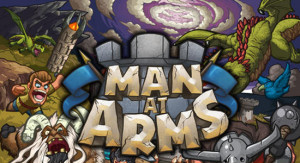Man at Arms is the latest game from a mobile developer that why few people have likely heard of. They have released several games for iOS, but this is the first that has stood out from the crowd. What have they done to the the tower defense formula that can differentiate this game from the rest in a densely packed market? Loot. Yes, Man at Arms takes fun of random drops and blends it with a well-established genre that has never experienced its magic before. This review focuses on the iPad version, but a pocket edition is also available for the iPhone.
At its core, Man at Arms is a tower defense game that plays very much like Kingdom Rush. This means that instead of just placing towers to shoot passing enemies, barracks must also be placed that will produce a small number of soldiers that can ‘tank’ enemies and keep them locked in combat while towers rain death upon them. Waves of enemies usually come in packs rather than a single file line, so the use of soldiers to hold enemies in place is essential. The ranged towers come in three different types. There are archers, who will easily dispose of smaller creatures; cannons, that will provide splash damage; and mages, who will use magic to bypass any pesky armour that larger enemies might be waring.
Each map contains a limited number of plots that can contain a tower. Towers can be upgraded, providing the player has the appropriate cards (more on this later). The player begins with twenty life, and must stop with waves of advancing monsters from reaching the other side of the map before their life is depleted. This is attained not only with strategically placed towers, but with abilities as well. Abilities are either dealing damage to the select enemies through physical or magical means, or summoning extra troops to hold more enemies in place. The towers, upgrades, and abilities that a player has access to in any level is based on their deck, and this is the unique selling point of Man at Arms.
A new player will begin the game with barracks and archers towers, and will be introduced to cannons and mages through a light tutorial contained in the first couple of levels. Victories in the early levels also award higher level versions of towers to place in ones deck. This is required to upgrade towers during a level, and both a level one and a level two tower of a given type must be in a deck to allow it to be used. Having just a level two version will prevent the tower from being build in the first place! Random cards can drop during a level as well, and these can include ‘enhanced’ versions of the cards which are slightly better in some fashion.
Building a successful deck is not easy, and more space must constantly unlocked to keep up with the difficulty curve of the levels. Each card in a deck has a cost associated with it and therefore prevents the player from using every card they have access to. More powerful versions of the same card will have a higher cost, but do not lock players from using weaker version of the same card in a deck. Abilities are useful in this way, as several of the same type can be used in a level, and each will have its own cooldown between uses.
Also worth noting is that there are different versions of each tower. For instance, a level one mage may also come with a soldier that will hang around, even as the tower is upgraded. An archers tower may come with a mage, but the mage will be replaced with a second archer as the tower is upgraded. Level four towers also vary, and have unique upgrades based on which variation a player has chosen. For example, an archers tower could shoot fire arrows at level four, and be upgraded to burn enemies over time; or instead deal holy damage, and have access to a different upgrade.
Special cards can be added to a deck that will let a towers access the unique upgrades, regardless of their level or variation. Card can also increase damage for specific tower types, increase range, decrease cost, or improve abilities in some fashion. There is an in-game store that will sell extra card to the player for gems. These can easily be obtained while playing the game, or be bought for real money if a player wants to skip the fun. Old cards can also be combined together to produce something new and potentially much better.
Man at Arms also features a full level editor so that a player can produce their own maps and share them with friends. Any enemy seen in the game is also given as a card to be used in constructing a map, and these enemy cards can be combined to get enhanced versions that could pose a problem for veterans of the game, and will add to the longevity of the title.
The music in Man at Arms does not really stand out in any way, but the graphics are gorgeous, even on a larger screen. Allies and enemies alike are well animated and projectiles can clearly be seen traveling across the screen. The game can also handle a fair amount of action on the screen at once, and later levels can quickly have hordes of enemies marching toward their inevitable demise.
Customising towers in a tower defense game has been done before, and Prime World: Defenders has even gone down the route of using deck building in the genre. Nothing so far though has offered the Diablo style loot system used by Man at Arms, and that is enough to make it stand out from the rest.


